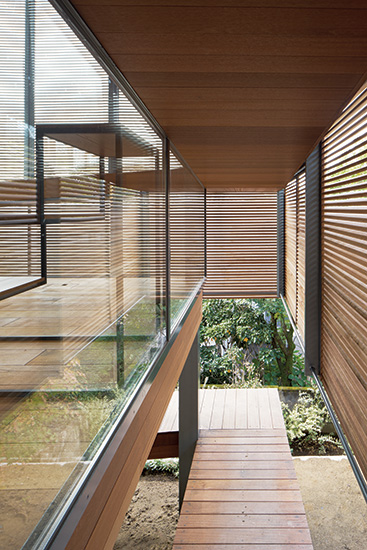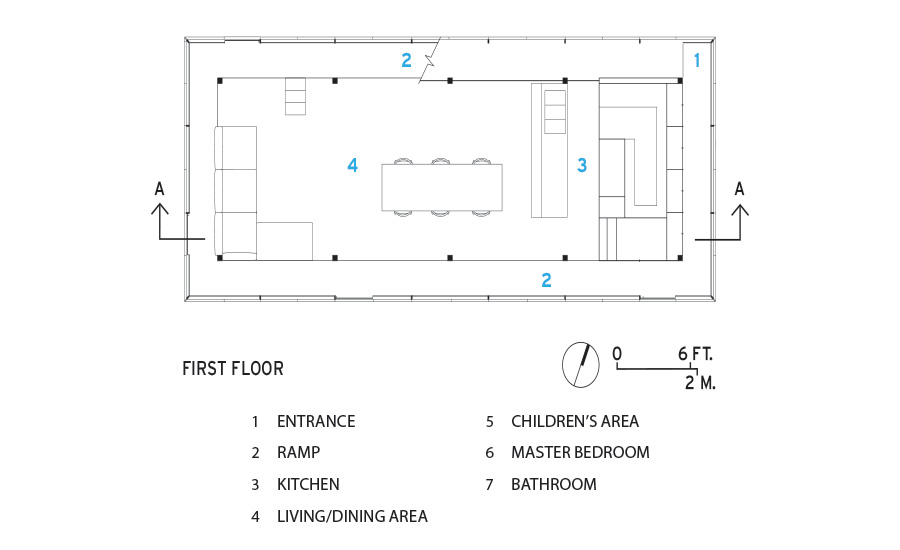Located in an exclusive Tokyo neighborhood defined by gracious, tree-lined avenues, the modest wood-shuttered house designed by the Tokyo firm TNA is a Maison Domino structure with a twist. Like Le Corbusier’s conceptual model, it consists of simple slabs and columns. While the piloti elevate the building above the ground, a spiraling ramp wraps its perimeter, seamlessly stitching all of its levels together in one tidy package—without any stairs.
Additional Information:Jump to People/Products
Named Helix House by the architects, the project began with a cold call from the clients, a couple with three school-age children. Impressed with an earlier TNA home, Ring House (RECORD, April 2007, page 106), they contacted the husband-and-wife firm, hoping to build something on their newly purchased 1,875-square-foot plot. Many of the area’s old houses no longer exist, but unusually strict building codes help maintain a distinctive character for the community.
Although those requirements would not affect the architectural style, they did call for setbacks and certain limits on dimensions. And, unlike what’s allowed in other parts of the city, the architects could not build underground; neither could they create more than two stories of habitable space. Additionally, on the north face, the could only install small windows for ventilation, lest they compromise their neighbor’s privacy (large windows on the south side are common in Japan). “The restrictions were the most harsh we’ve ever encountered,” says TNA principal Makoto Takei. But all those rules turned out to be catalysts for invention.
Instead of following the local convention of placing a shuttered garage and walled garden on the street, the architects raised the house and put the yard beneath it. This not only opened up the urban fabric, it distanced the residence from street activity, which preserves privacy while creating a protected parking and play area under the house. Covered with sand, this outdoor space is where the ramp begins its ascent to the entrance.
As it rises, the gradient encircles much of the site before reaching the modest main entrance, tucked directly behind the raised facade. The ramp crosses the threshold and continues inside the house, sandwiched between the facade and a thick storage wall. From there it leads to a 1,355-square-foot interior space: a wood-paneled kitchen, dining, and living area, followed by the private quarters on the second floor comprising three cubicles for the children, a bathroom, and the master bedroom. In contrast to their parents’ room, with its expansive view, the siblings occupy compact sleeping berths, each containing a captain’s bed and cubbies. These open directly to a shared study area, where a built-in communal desk parallels the ramp beyond.
Measuring 2½ feet wide by 345 feet long, the ramp ranges in slope from 1:10 at its steepest to 1:18 at its gentlest. (For every 10 or 18 units of horizontal distance there is one unit of vertical rise.) Except for modular steps added to create a shortcut, the ramp is the sole circulation path, yet it is not simply a conduit connecting levels: it is as much a part of the furniture as it is of the architecture, providing a place to sit, lie, or play.
The Helix House ramp blurs the divide between inside and out as it winds its way into the house and then out again before reaching the roof. Clad in wood, it matches both the interior and exterior surfaces. “Because the clients’ previous house had white walls, we wanted something different,” explains Takei. Their choice was to use teak not just for the ramp but also the ceilings, floors, cabinetry, dining table, and other custom furnishings. The only white surfaces are in the bathroom.
TNA selected Nyatoh wood for the exterior louvered wall panels that give the building its sleek appearance. Concealing an inner layer of insulated double glazing that shuts out the elements, most of the panels are fixed. Of the 12 that are movable, six cover operable windows of various sizes. The louvers’ elegantly tapered fins are angled at 25 degrees, maximizing views out but minimizing views in. A steel framing system, invisibly integrated with the window sashes, supports the weight of the outer walls. Cantilevered steel beams concealed within the ramp transfer this load to the main structure: 10 steel columns on the two upper levels supported by six piloti at grade.
“When we went to school, no one designed with piloti,” says Takei. According to the architect, despite Japan’s love of post-and-beam construction, these components were thought to be expensive and inefficient. Yet that didn’t derail TNA: “We always pay close attention to how our buildings meet the ground,” Takei says. And old ideas have ways of resurfacing. By adapting Le Corbusier’s columns/piloti/architectural promenade in the ramp, TNA created a cozy interior where the family enjoys gathering, plus a protected exterior where they can appreciate nature even in the heart of the city. Buried in this historic concept was TNA’s chance to unearth a new solution for Helix House.
PeopleArchitect: Makoto Takei + Chie Nabeshima / TNA 9-7-3F, Sumiyoshi-chou,Shinjyuku-ku,TOKYO,JAPAN TEL +81-(0)3-3225-1901 FAX +81-(0)3-3225-1902
Structural engineer: Yakutaka Konishi / Konishi Structural Engineers
Photographer: Daici Ano
General Contractor: Shigeya Morioka, Ryousuke Oogata / TH-Morioka
Client: withheld
Size: 1,355 square feet
Cost: withheld
Completion Date: September 2015 architecture — Jean-François
Milou, lead architect; Wenmin Ho,
Thomas Rouyrre, architectural
team managers; Charmaine Boh,
Janis Goh, Trung Thanh Nguyen,
Jason Tan, Jiarong Goh, May Leong,
Eudora Tan, architectural designers
|
ProductsStructural system Steel frame
Exterior cladding Louver hard wood
Roofing FRP
Windows Steel frame
Glazing Heat-resistant pair glass
Interior finishes Every surface (ceilings, wall coverings, floor) is teak wood
Furnishings Chairs: PP68 (Carl Hansen / Hans J Wegner) Tables: TNA original design. Sofa: TNA original design. Step: TNA original design.
Lighting Stand lighting: Daphine floor (Lumina) Task lighting: Daphine (Lumina)
|




































